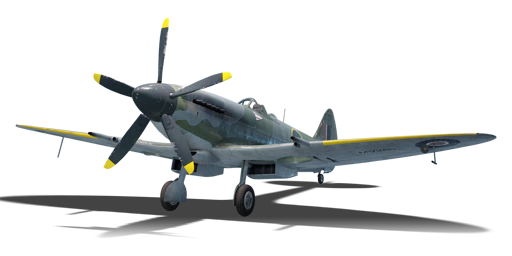



The Spitfire F Mk XIVe was a British WWII-period fighter. Unlike the previous Griffon-powered Mk XIV, the XIVe featured a lowered tail section allowing for better rear view, as well as a new bubble canopy. The armament also differed from the regular Mk XIV as it featured an "E" type wing with two 20 mm Hispano cannons and two 12.7 mm Browning M2 machine guns instead of the "C" type with two cannons and four 7.7 mm machine guns.
The Spitfire F Mk XIVe was introduced in Update 1.41. Featuring much greater engine power due to its Griffon engine, the Mk XIVe is faster than the previous Merlin-powered variants, at the cost of decreased maneuverability. However, the Spitfire is still able to out-turn most of its opponents while retaining the great climb rate and speed.
flaps
flaps
flaps
brake
| Belt | Belt filling | Armor penetration (mm) at a distance: | |||||
|---|---|---|---|---|---|---|---|
| 10 m | 100 m | 500 m | 1000 m | 1500 m | 2000 m | ||
| HEI/SAP-I/T | 22 | 20 | 14 | 9 | 6 | 4 | |
| AP-T/HEI/SAP-I | 37 | 35 | 25 | 16 | 10 | 7 | |
| T/HEI/SAP-I/HEI/SAP-I | 22 | 20 | 14 | 9 | 6 | 4 | |
| AP-T/T/HEI | 37 | 35 | 25 | 16 | 10 | 7 | |
| AP-T/SAP-I/HEI/AP-T | 37 | 35 | 25 | 16 | 10 | 7 | |
| HEI/HEI/SAP-I | 22 | 20 | 14 | 9 | 6 | 4 | |
| Belt | Belt filling | Armor penetration (mm) at a distance: | |||||
|---|---|---|---|---|---|---|---|
| 10 m | 100 m | 500 m | 1000 m | 1500 m | 2000 m | ||
| T/Ball/Ball/I/AP-I | 26 | 24 | 18 | 12 | 8 | 5 | |
| AP-I/AP-I/AP-I/T/I | 26 | 24 | 18 | 12 | 8 | 5 | |
| T/AP/AP/AP-I/AP-I/I | 30 | 27 | 20 | 13 | 9 | 6 | |
| T/T/T/T/T/AP-I | 26 | 24 | 18 | 12 | 8 | 5 | |
| AP-I/AP-I/AP-I/I/I | 26 | 24 | 18 | 12 | 8 | 5 | |












Flight performance | |
|---|---|
Survivability |
|---|
Weaponry | |
|---|---|